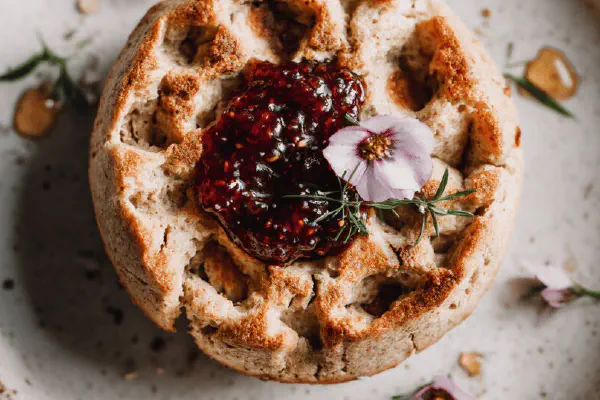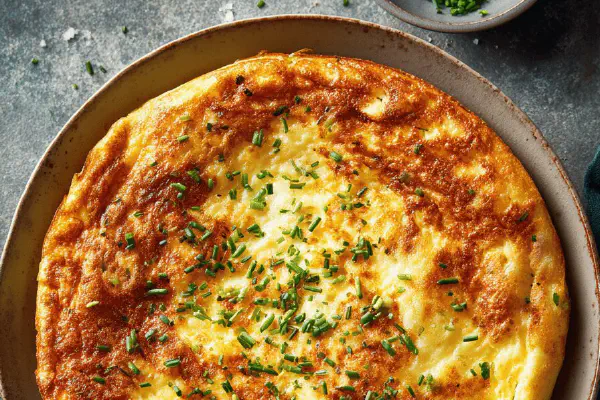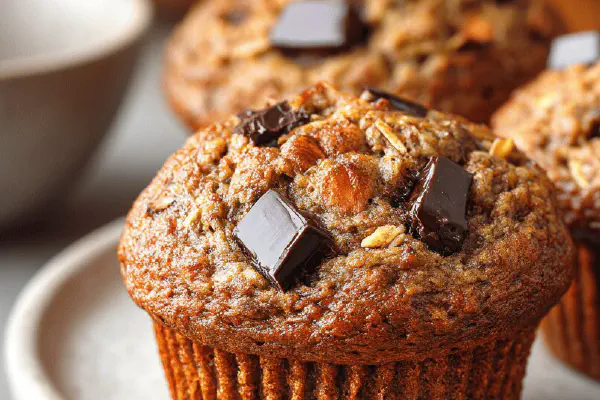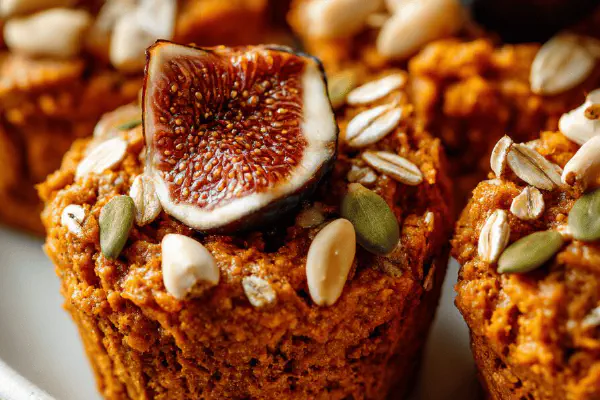Buttermilk Rye Crumpets

E
By Emma
Certified Culinary Professional
•
Recipe tested & approved
A twist on classic crumpets using part rye flour and a blend of milk and water. Yeast bubbles signal readiness, combined with baking soda to lighten the batter. Cooked in well-oiled metal rings for that signature holey surface. Serve warm with floral jam or sharp honey. No eggs here, easy vegetarian staple, no nuts either. Adjusting rise and cooking times helps with imperfect kitchens and varies humidity. Substituting oat milk works but texture shifts, oils must be clarified butter or neutral veggie. Attention to gentle folding prevents deflated batter, watch the holes—not just a timer. A few small changes to quantities for a deeper flavor and different crumb. Handled properly, you get crumpets with crisp edges and soft spongy interiors.
Prep:
25 min
Cook:
35 min
Total:
60 min
Servings:
16 pieces
#British
#vegetarian
#baking
#breakfast
#crumpets
Started with plain white crumpets before mixing rye in. Rye adds earthiness without heaviness but watch liquid balance—it thickens batter slightly. Buttermilk key; acidity activates baking soda for bubbles, tangy flavor builds under the yeast’s sweet notes. Tried almond milk once for dairy-free; okay but texture changed, less rise. If no metal rings, thick wide cookie cutters work but oil inside well, or risk sticking. Batter should never be too runny or too stiff—aim for heavy cream consistency or you lose holes. Timing less important than looking; holes appearing on surface is your cue to flip, not clock. Over-flipping or too hot and you get dense, flat. Patience key here. Loved warming them slowly in oven to keep texture intact without drying.
Ingredients
- 280 ml buttermilk
- 200 ml lukewarm water
- 10 ml instant yeast
- 5 ml granulated sugar
- 140 g all-purpose unbleached flour
- 70 g rye flour
- 6 ml fine sea salt
- 3 ml baking soda
- Clarified butter or mild vegetable oil for rings
About the ingredients
Use a blend of all-purpose and rye flour for texture contrast. Rye provides robustness but keeps the crumb tender, avoid too much rye—it weighs down batter. Buttermilk is non-negotiable; its acid reacts with baking soda to create true crumpet holes and flavor. If necessity calls, substitute buttermilk with plain yogurt thinned with a splash of milk or water. Instant yeast preferable for speed and reliability. Baking soda added late post-initial rise prevents premature reaction and collapse. Oils should be neutral but clarified butter gives a nutty aroma, far better than plain vegetable oils. Keep rings oiled after every batch to avoid sticky nightmares. Water temperature matters—too hot kills yeast, too cold delays it; lukewarm is just right. Salt timing: mixed with flour upfront to ensure even dispersion without yeast inhibition.
Method
- Warm buttermilk with 160 ml water; stir in yeast and sugar until smooth. Wait 5 minutes—look for subtle bubbles signalling yeast activity, faint yeasty aroma developing.
- Combine both flours and salt in large bowl. Pour wet mix over dry. Whisk gently but thoroughly. No lumps, batter thick but pourable, resembles thick cream. Cover with damp cloth or plastic wrap. Ideal spot: warm and draft-free. Wait 50-55 minutes until doubled, texture soft and light; poke with finger for bounce.
- Mix remaining 40 ml water with baking soda separately. Fold this gently into risen batter—delicate maneuver to keep air. Rest another 25-30 minutes. Surface slightly domed, bubbles on top start popping; smell like faintly sweet grain.
- Heat heavy skillet (cast iron preferred) over medium. Brush four 9 cm diameter metal rings with oil or clarified butter thoroughly inside and around edge to prevent sticking.
- Set rings on skillet, heat 2-3 minutes until shimmering heat detectable, slight oil shimmer or faint smoke.
- For each ring, pour 55 ml batter in center. Surface tightens, small holes start appearing after 4-5 minutes. When edges firm up but center still wet, loosen gently with thin metal spatula. Flip rings and crumpets carefully as one unit, cook 2.5-3 minutes more.
- Remove rings immediately to avoid soggy sides. Keep crumpets warm in oven at low heat, 90-95 °C, on rack to avoid condensation buildup. Repeat with remaining batter. Crumpets should have open, holey top and golden underside, edges slightly crisp.
- Serve warm, open-faced with tangy honey or sharp raspberry preserves. Butter melting into the holes. Great fresh but also try toasted leftovers.
Cooking tips
Watch batter, not the clock. After first rise, batter doubles, airy, wobbly. Mix baking soda water gently into batter to avoid knocking out precious air bubbles. Heat cast iron skillet well before adding rings; too cool leads to thick edges, not uniform. Pouring into hot rings promotes bubble rise on top surface instead of edges. Holes forming is your sensory guide; glossy, holey surface means flip time. Use thin metal spatula to slide under crumpet plus ring—it’s delicate but necessary to keep shape. Upon flipping, edge color changes to golden brown quickly, smell becomes toasted. Avoid flipping too early or batter sticks and collapses. Keep cooked crumpets in low oven on rack, not stacked, prevents sogginess. Serve promptly or reheat briefly without drying. Keep extra batter covered well during cooking to maintain rise.
Chef's notes
- 💡 Yeast bubbling subtle. Wait for faint aroma and small bubbles. Timing flexible but sensory strict. Over stirring kills air. Fold baking soda gently after rise. Keeps batter aerated; preserves light holes.
- 💡 Oil rings well inside and edges. Use clarified butter or neutral oil. Skip heavy oils that smoke or smell strong. Rings cold mess the rise; heat skillet first then add rings. Hot rings help bubbles rise on surface, not sides.
- 💡 Pour batter in hot rings steady. Thickness matters. Thin runs, no holes. Too thick stays gummy. Aim for thick cream texture, thicker than pancake but pourable. Watch surface for tiny holes—flip timing, not clock.
- 💡 Flip carefully with thin metal spatula plus ring. Flip before holes close or batter dries too much. Crisp edges show soon after flip, smell toasted. Remove rings immediately to avoid steamy soggy sides.
- 💡 Keep cooked crumpets warm oven 90-95 °C on rack; prevents condensation on bottom. Don’t stack or wrap hot. Crumpets lose crisp edge fast if stacked. Toast leftovers briefly to restore texture.
Common questions
Can I replace buttermilk?
Use plain yogurt thinned with milk or water. Lower rise chance. Tang less strong. Try oat milk if vegan but expect texture shifts; crumpets denser, fewer holes.
What if batter too runny or thick?
Runny batter means no bubbles, spreads too much. Add flour carefully for thickening. Too stiff batter causes dense crumpets, no rise. Aim for thick cream-ish consistency.
How to know when to flip?
Watch surface. Small holes show bubbling, edges firm but center still wet. Smell toasted aroma soon after flip. Don’t rely on timer alone, bubble timing always better.
Storage tips for crumpets?
Cool fully. Store loosely covered at room temp if eating same day. Fridge slows texture, wrap tight if necessary. Reheat oven or toast; avoids sogginess. Freeze flat in airtight bag for longer.



